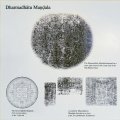Buddhist Art Gallery: Northern Himalayan Section: photo 115
Photo 115 of 198 in Gallery: Buddhist Art Gallery: Northern Himalayan Section

Image title: Structure of Mandala
Description of the photo
English text:
The Mandala as an Aerial View of the World—The typical mandala is composed of a number of superimposed concentric circles and squares, and occasionally, triangles. Depicted at the outermost edge is a wheel of flames, which represents the basic elements of the world: earth, water, fire, and wind. At the inner side is a ring of diamond-like vajra, which serves to protect the mandala from external enemies.
Moving inward, we find a ring of lotus petals. Inside these rings is a tower equipped with four gates, which stands on the peak of Mount Meru (Sumeru). Thus, the mandala depicts, from directly above, a tower built upon a giant lotus blossoming on the peak of Mount Meru. The outermost wheel of fire is visible protruding beyond Mount Meru, and is made up of the four elements of wind, fire, water, and earth, shown in order from lowest to highest. The roof of the tower is transparent, and it is possible to see the figures of the Buddhas who dwell within.
These Buddhas vary according to the traditions of the mandalas, but the most common are the five Buddhas, Mahavairocana, Aksobhya, Ratnasambhava, Amitābha, and Amoghasiddhi. These Buddhas symbolize the “five aggregates” or five elements of body and mind: matter, sensation, simple concept, volition, and consciousness. Thus, the mandala simultaneously depicts both the universe and the individual, and in this way serves as a medium for the union of the cosmos and the self.
The outer structure of the Mandala:
The Cage of Vajras;
Origin of the World;
The Fence of Vajras;
The Garland of Vajras;
The Earth of Vajras;
The four elements in the Origin of the World:
Earth;
Water;
Fire;
Air;
Nepalese text (not proofread)
मण्डल - विश्व ब्रम्हाण्डको आकाशीय दृश्य—मण्डल, विशेषतः एउटा समविन्दु भएका वृत्त तथा वर्गाकारहरूको परिष्कृतिक संयोजन हो । कुनै कुनै मण्डलमा त्रिकोणहरू पनि समायोजन भएको हुन्छ । मण्डलको बाहिरी भागलाई अग्नीज्वाला (ज्वालावली) ले घेरिएको हुन्छ, जुन संसारको मूल तत्त्व अर्थात् चतुर्महाभूत: पृथ्वी, जल, अग्नी र वायुका प्रतिक हुन् । ज्वालावली सँगैको भित्री घेरामा वज्रमाला अर्थात् वज्रावली रहेको हुन्छ । यसले मण्डललाई वाह्य शक्ति वा विघ्न बाधा हुनेबाट रक्षा गर्दछ ।
वज्रावलीको पनि भित्री चक्कामा कमलपुष्पदल अर्थात् पद्मावलीले घेरिएको पाउँछौं। यी चक्काहरूदेखि भित्री भागमा चतुर्दिशामा चार द्वारले सुसज्जित सुमेरु पर्वत माथि एक स्तम्भ (बुर्जा) उभ्याइएको पाउँछौं । यसरी बनाइएको मण्डललाई ठीक माथिबाट हेर्दा एउटा विशाल कमलको फूल माथि सुमेरु पर्वत र त्यस माथि एक स्तम्भ अवस्थित भैरहेको पाउँछौं । मण्डलको सबभन्दा बाहिरी परीधिको ज्वालावलीको अग्नी ज्वाला, जुन चतुर्महाभुतबाट बनेको छ, सुमेरु पर्वतबाट निस्किएर तलदेखि क्रमशः माथिसम्म प्रज्वलित भइरहेको भान हुन्छ । छाना युक्त बुर्जा पूर्ण रूपमा निर्मल तथा पारदर्शी रहेको हुन्छ र उक्त स्थानमा विराजमान भएका भगवान बुद्धहरूलाई दर्शन पाउँन सकिन्छ ।
मण्डलमा विराजमान हुने बुद्धहरू मण्डलको प्रकृया तथा परम्परा अनुसार फरक फरक हुन सक्दछ । तर साधारणतया पञ्चबुद्ध वैरोचन, अक्षोभ्य, रत्नसम्भव, अमिताभ र अमोघसिद्धि बुद्धहरू नै मण्डलमा विराजमान भएको पाइन्छ। ती बुद्धहरू हाम्रो शरीर तथा मनको पञ्चस्कन्ध वा पञ्चतत्त्व अर्थात् रूप, वेदना, संस्कार, संज्ञा, विज्ञानका प्रतिक हुन् । यसरी मण्डल समस्त जीव र ब्रम्हाण्डको संयोजन हो र यहि नै आफू र संसारलाई एकत्त्व गराउने माध्यम पनि हो ।
Nepalese to English (automated translation)
Mandala - Celestial View of the Universe—A mandala, in particular, is a sophisticated combination of concentric circles and squares. Triangles are also adjusted in some circles. The outer part of the mandala is surrounded by flames, which represent the basic elements of the world, i.e. the four elements: earth, water, fire and air. There is Vajramala or Vajravali in the inner circle along with Jwalavali. It protects the mandala from external forces or obstacles.
In the inner wheel of Vajravali too we find a lotus flower i.e. Padmavali surrounded. From these wheels, we find a pillar (burja) erected on top of Mount Sumeru equipped with four doors in Chaturdisha. If we look at the mandala made in this way from above, we find Sumeru Parbat on top of a huge lotus flower and a pillar on top of it. The fiery flame of the outermost periphery of the mandala, which is made of Chaturmahabhuta, appears to be emanating from Mount Sumeru and gradually igniting from the bottom to the top. The roofed tower is completely pure and transparent and one can have a glimpse of Lord Buddha seated at that place.
The Buddhas sitting in the mandala can be different according to the process and tradition of the mandala. But generally Panchabuddha Vairochana, Akshobhya, Ratnasambhava, Amitabha and Amoghasiddhi Buddhas are seated in the mandala. Those Buddhas are the symbols of Panchaskandha or Panchatattva of our body and mind, i.e. Form, Pain, Sanskar, Noun, Science. In this way, Mandala is a combination of all living beings and the universe, and it is also a means of uniting oneself and the world.
Transcription (with diacritics):
Maṇḍala - viśva bramhāṇḍako ākāśīya dṛśya—maṇḍala, viśeṣataḥ euṭā samavindu bhaekā vṛtta tathā vargākāraharūko pariṣkṛtika saṃyojana ho . Kunai kunai maṇḍalamā trikoṇaharū pani samāyojana bhaeko huncha . Maṇḍalako bāhirī bhāgalāī agnījvālā (jvālāvalī) le gherieko huncha, juna saṃsārako mūla tattva arthāt caturmahābhūta: pṛthvī, jala, agnī ra vāyukā pratika hun . Jvālāvalī saँgaiko bhitrī gherāmā vajramālā arthāt vajrāvalī raheko huncha . Yasale maṇḍalalāī vāhya śakti vā vighna bādhā hunebāṭa rakṣā gardacha .
vajrāvalīko pani bhitrī cakkāmā kamalapuṣpadala arthāt padmāvalīle gherieko pāuṃchauṃ. Yī cakkāharūdekhi bhitrī bhāgamā caturdiśāmā cāra dvārale susajjita sumeru parvata māthi eka stambha (burjā) ubhyāieko pāuṃchauṃ . Yasarī banāieko maṇḍalalāī ṭhīka māthibāṭa herdā euṭā viśāla kamalako phūla māthi sumeru parvata ra tyasa māthi eka stambha avasthita bhairaheko pāuṃchauṃ . Maṇḍalako sababhandā bāhirī parīdhiko jvālāvalīko agnī jvālā, juna caturmahābhutabāṭa baneko cha, sumeru parvatabāṭa niskiera taladekhi kramaśaḥ māthisamma prajvalita bhairaheko bhāna huncha . Chānā yukta burjā pūrṇa rūpamā nirmala tathā pāradarśī raheko huncha ra ukta sthānamā virājamāna bhaekā bhagavāna buddhaharūlāī darśana pāuṃna sakincha .
maṇḍalamā virājamāna hune buddhaharū maṇḍalako prakṛyā tathā paramparā anusāra pharaka pharaka huna sakdacha . Tara sādhāraṇatayā pañcabuddha vairocana, akṣobhya, ratnasambhava, amitābha ra amoghasiddhi buddhaharū nai maṇḍalamā virājamāna bhaeko pāincha. Tī buddhaharū hāmro śarīra tathā manako pañcaskandha vā pañcatattva arthāt rūpa, vedanā, saṃskāra, saṃjñā, vijñānakā pratika hun . Yasarī maṇḍala samasta jīva ra bramhāṇḍako saṃyojana ho ra yahi nai āphū ra saṃsāralāī ekattva garāune mādhyama pani ho .
Transcription (without diacritics):
mandala - vishva bramhandako akashiya drishya—mandala, visheshatah euta samavindu bhaeka vritta tatha vargakaraharuko parishkritika samyojana ho . kunai kunai mandalama trikonaharu pani samayojana bhaeko huncha . mandalako bahiri bhagalai agnijvala (jvalavali) le gherieko huncha, juna samsarako mula tattva arthat caturmahabhuta: prithvi, jala, agni ra vayuka pratika hun . jvalavali saँgaiko bhitri gherama vajramala arthat vajravali raheko huncha . yasale mandalalai vahya shakti va vighna badha hunebata raksha gardacha .
vajravaliko pani bhitri cakkama kamalapushpadala arthat padmavalile gherieko paumchaum. yi cakkaharudekhi bhitri bhagama caturdishama cara dvarale susajjita sumeru parvata mathi eka stambha (burja) ubhyaieko paumchaum . yasari banaieko mandalalai thika mathibata herda euta vishala kamalako phula mathi sumeru parvata ra tyasa mathi eka stambha avasthita bhairaheko paumchaum . mandalako sababhanda bahiri paridhiko jvalavaliko agni jvala, juna caturmahabhutabata baneko cha, sumeru parvatabata niskiera taladekhi kramashah mathisamma prajvalita bhairaheko bhana huncha . chana yukta burja purna rupama nirmala tatha paradarshi raheko huncha ra ukta sthanama virajamana bhaeka bhagavana buddhaharulai darshana paumna sakincha .
mandalama virajamana hune buddhaharu mandalako prakriya tatha parampara anusara pharaka pharaka huna sakdacha . tara sadharanataya pancabuddha vairocana, akshobhya, ratnasambhava, amitabha ra amoghasiddhi buddhaharu nai mandalama virajamana bhaeko paincha. ti buddhaharu hamro sharira tatha manako pancaskandha va pancatattva arthat rupa, vedana, samskara, samjna, vijnanaka pratika hun . yasari mandala samasta jiva ra bramhandako samyojana ho ra yahi nai aphu ra samsaralai ekattva garaune madhyama pani ho .
Gallery information:
The Northern Himalayan region in Nepal offers a wide variety of Buddhist objects such as paintings, scriptures, sculptures, ritualistic objects, etc. Buddhism once entered Tibet from Nepal and has blended in its own way there, resulting in Tibetan Buddhism which is divided into many schools. The items found here are exhibited in the National Museum of Nepal (Rashtriya Museum).
Photo details:
Date: 2019-12-04
Camera: SONY ILCE-6400
Exposure: 1/160
Aperture: f/4
ISO: 3200
Focal length: 19mm
High resolution:
Download file
Size: 2.87 MB
Resolution: 2000 x 2026
© Photograph by Gabe Hiemstra.
License: CC BY-NC-ND 4.0

